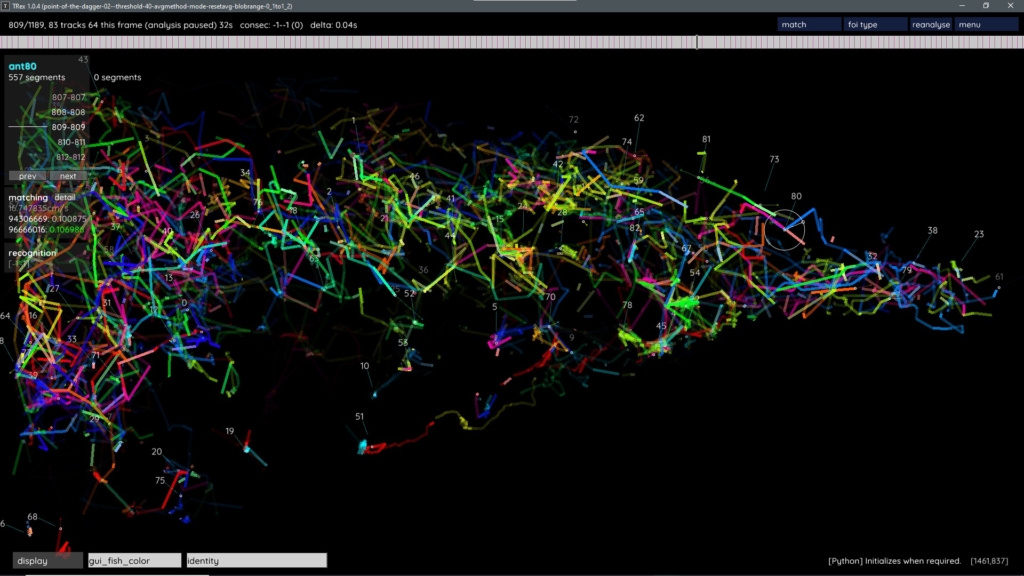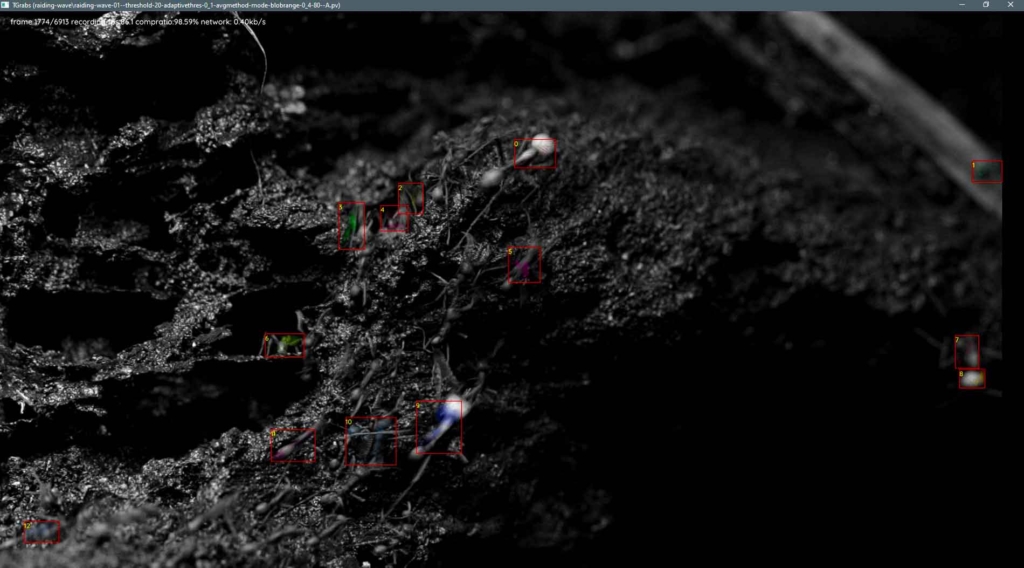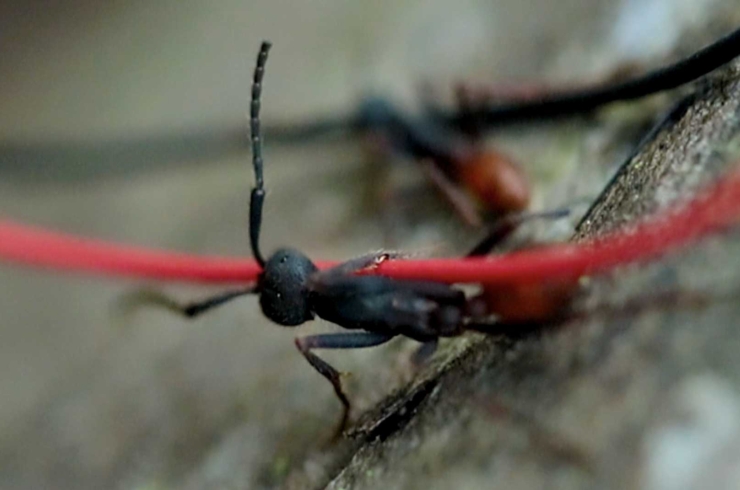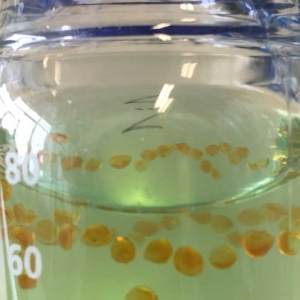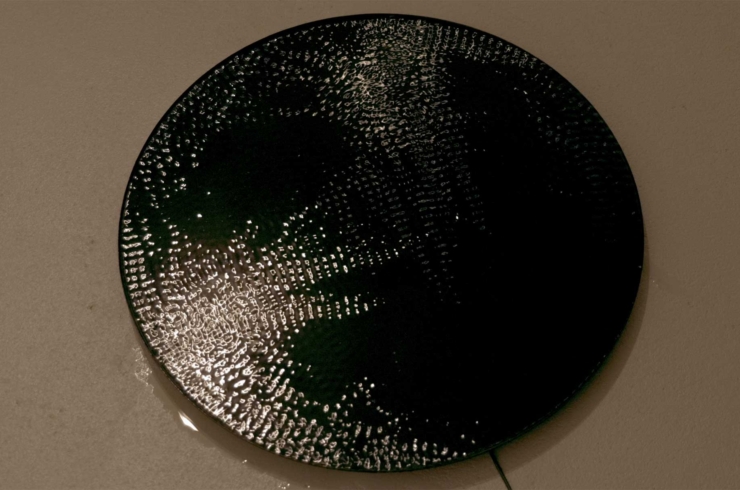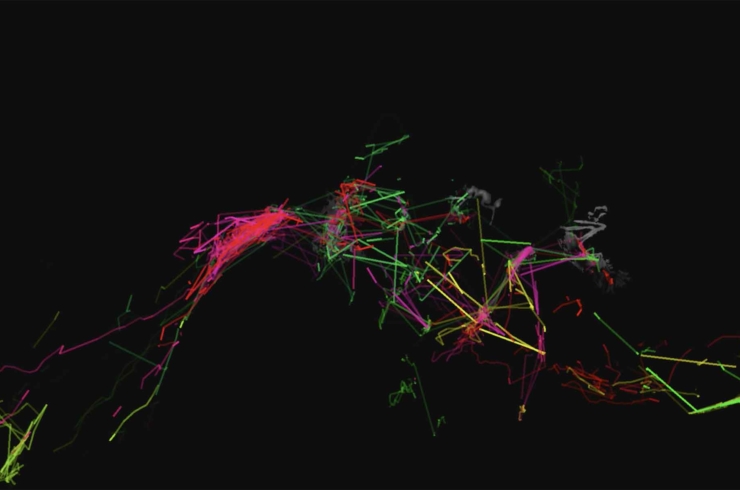Tiam Movements
Installation module inspired by the Sarayaku concept of tiam using convolutional algorithms, piezoelectric interferences, water vibrations, and olfaction
“It is important to be reborn, to reconnect with Pachamama again, with Kawsak Sacha. It is a question of the interior, a question of wisdom. The closer we get, the better Pachamama can continue to recover her health. We call it ‘tiam,’ the return, turning around to change perspectives, a new look. That is the meaning of tiam” (Angun 2019).
In Sarayaku, tiam means radical turns, change of perspective, or return. Tiam emphasises the turn as a creative performance, a conductive thread for weaving the necessary relational tensions with other species, for moving and reacting according to local rhythms.
The concept of tiam has been applied in the way I deployed and used camera, sound equipment, and electronic sensors in situ across Sarayaku to bring into being a radical shift in perspective: army ants transforming into rain messengers. Tiam is inspected through changes in ants’ trajectories which lead to processes of reterritorialisation of their social fabric. Not all ants move together in the same direction. Some turn left and right, others suddenly decide to return.
This multi-sensory installation focuses on repurposing computational techniques with electronic media to render a visual and olfactory representation of the radical movements of tamya añanku and their intimate/antagonistic relation with the rain. I employed convolutional algorithms using TRex to draw the movements of rain ants when they migrate and weave corporeal shelters and bridges. Piezoelectricity was deployed to record acoustic vibrations and electrical variations whenever the ants run across the forest floor or directly interacted with the piezoelectric discs. The recorded sounds and numeric values were employed to create different oscillations on a water film using a transducer underneath an aluminium plate. Woven patterns and transitory shapes are created by these means. The water film is infused with drops of geosmin, a synthesised compound of the scent of wet earth after rain. The scent of skatole, which is the characteristic odour of rain ants when tangled up together, was present in the exhibition room in the form of microcapsules. These compounds were created with the assistance of Dr. Latnikova from Fraunhofer Institute for Applied Polymer research.
By guiding my tactical mediation with tiam, the movements of tamya añanku demonstrate an interconnection with the forces of rain and their oscillating energies: transitory turning motions, olfactory tunnels and fluid migrations, corporeal bridges woven over bodies of water, and shelters woven against the rain. Rain ants’ performances are fluid in the apprehension of collective movements, however, frame by frame individual ant trajectories show divergences and deviations—ants crossing, turning and returning, exchanging places in the fabrics they weave, and moving in opposite directions, leading to unforeseeable transversal patterns: an invertebrate social fabric that adjusts to the lifeforces in formation of this rainforest.
Operations:
amplification
interference
convolution
Materials:
1 video channel, 1 vibrating plate with transducer (40 Watts), water diluted with the scent of earth after rain, skatole, the scent of rain ants, in microcapsules (synthesised at Potsdam Fraunhofer Institute for Applied Polymers), piezoelectric amplifiers were employed to record vibrations produced by ants when they move
Piezoelectric Interferences and Olfaction
Piezoelectric amplifiers were used to record vibrations of invertebrate movements in diverse situations, including unexpected interactions of dragging, stinging, or licking the interfering devices. These field recordings became a library of sounds to work on musical compositions. An array of three piezoelectric discs connected to a Raspberry Pi micro-computer enabled the registry of electric variations whenever the ants crossed over, or interacted with, these interfering devices.
Geosmin and skatole were concocted at Fraunhofer Institute for Applied Polymers, in fluid form and imicrocapsules.
Installation setup and algorithmic operations
The piezoelectric data were used as variables in acoustic compositions together with the tracking data (X,Y coordinates) from motion ant detection using TRex software (e.g., to change pitch, notes, and sound envelopes).
The acoustic compositions were then transmitted to a transducer underneath a circular vibrating plate to generate woven patterns on the water surface, which aimed at showing the interwoven connection between rain and ants. The thin water film on the vibrating plate is mixed with drops of geosmin. The resulting resonance on the water, produced by the transduction of acoustics, was aimed at facilitating the diffusion and dispersion of the scent of earth after rain.
The characteristic musky scent of rain ants, skatole, was presented on the exhibition wall as encapsulated powder substance.
Convolutional Neural Networks and Sound Processing
First and second images: TRex open-source freeware based on algorithms for tracking small individuals; using convolutional neural networks the application can learn to detect body features and trace their movements.
Third image: Cycling 74’s MaxMSP software for electroacoustic compositions using SOM (self-organising maps for sound synthesis) with acoustic vibrations produced by the ants and recorded with piezoelectric amplifiers in Sarayaku. After that first step, I experimented with different compositions, feeding in more field recordings into this SOM processing, and using Tom Hall’s polyrhythm patch to create acoustic patterns for water vibrations.
- SOM based on: Machine learning library for Max by Benjamin D. Smith.
Smith, Benjamin D. and Guy E. Garnett. “Unsupervised Play: Machine Learning Toolkit for Max.” New Interfaces for Musical Expression (NIME). Ann Arbor, MI: ICMA, 2012.
